总算知道那个对外的接头是哪拆下来的了。。。货厂见到过好多次,我还以为是衰减器一类拆的。.
81857
%7B%22isLastPage%22%3Atrue%2C%22notes%22%3A%5B%5D%2C%22pid%22%3A%22834649%22%2C%22tid%22%3A%2281857%22%2C%22mainForumsId%22%3A%5B%22175%22%2C%22213%22%5D%2C%22categoriesId%22%3A%5B%220%22%5D%2C%22tcId%22%3A%5B%5D%7D
%7B%22isEditMode%22%3Afalse%7D
30GHz惠普驻波电桥拆解欣赏
定向电桥是矢量网络分析仪的基础零部件,它的性能直接关系到矢网的精度水平。惠普公司在上世纪80年代研制了以HP8516A(8510)为代表的高档矢量网络分析仪,覆盖从低频到40GHz的频率。
这里拆解的电桥来自HP8515A。该型号比较特殊,惠普(是德)的网站上查不到,频率范围介于8514和8516之间,但扩展到低频(其它型号均为45MHz),高频为26.5GHz。电桥可工作到更高频率,与HP8516A在高频段使用的应当是类似的技术,低频段明显不一样(体积都大好几倍)。
下面就言归正传
凑合一下看到三分之一频率,指标出色。而且,很难说不是因为那个Mini的负载回损不好……
![1.jpg]()
测试端口的样子
![2.jpg]()
撸起袖子加油拆,这是顶盖打开后的样子,一个弹簧压住一个小盖板
![3.jpg]()
把侧盖也打开,可以看到那个小盖板
![4.jpg]()
取下的零件和小盖板
![5.jpg]()
这是电桥的两个臂,按照惠普高端产品的习惯,应该是蓝宝石片上做的镀层
![6.jpg]()
用显微镜看一看,上面有4个电阻,两个电容。注意右下角狭缝中心的细线,那是同轴电缆的芯线。同轴电缆的外壳一端焊接在了桥的一个臂上。
![7.jpg]()
背面就是一个金属块塞上。当然塞多进去应该是根据机械配合和阻抗要求调过的。
![8.jpg]()
3.5连接器下面是一个可以拆卸的可阀过渡段(其实是空的,和空气线差不多的性能),这个零件支撑了刚才看到的蓝宝石电桥。
![9.jpg]()
不出所料,我把两个同轴支撑都取下来了。
![10.jpg]()
一头是一段可以伸缩的球头
![11.jpg]()
肚子里面有一个0.6mm左右的小弹簧
![12.jpg]()
蓝宝石已经只剩上面提到过的同轴线连着了,摇摇欲坠。这次拆解是希望不破坏现场、最后能够复装的,但是看到这里,就已经不详预感了。
![13.jpg]()
为了拆下同轴线,看到巴伦部分,必须从大肚子上开刀
![14.jpg]()
这个桥的机械设计很坑,英制的不到3mm的内六角螺丝在距离表面接近30厘米处,淘宝上搜遍,最长的螺丝刀只有25厘米长。。无奈,自己磨一把。
![15.jpg]()
还是拆下来了,就是最里面的螺丝孔
![16.jpg]()
华丽的内心闪亮登场
![17.jpg]()
然后,然后,同轴线断了。这些接头都涂了紧固胶,是上机床搞开的,因为3.5锁紧螺套被粘死无法旋动,不得不整体旋转拧断了内部的同轴线。其实后来想了下,断是必然的。要想不断,应该先拆小肚子,用烙铁搞开细同轴的一端;也可以先融化蓝宝石上的焊线。
![18.jpg]()
这个线需要用显微镜看
![19.jpg]()
外壳直径0.3mm
![20.jpg]()
绝缘体外径0.18mm。芯线直径……不好意思,我没有完整的剥开过。
![21.jpg]()
继续看巴伦,细同轴线此时套在了一个稍微粗点(大约1mm直径)的铜管内
![22.jpg]()
拆开以后——弹性的支架上放满了磁体材料,调节螺丝可以调整这些磁体的松紧
![23.jpg]()
磁体灰飞烟灭啦,看到了巴伦的核心部分
![24.jpg]()
巴伦处是两层套管,内层是0.8mm左右同轴线,然后装在1.2mm左右的镀金铜(不一定,看着像)管内。在最右侧,内层同轴线才转成刚才看到的0.3mm同轴线。由于最近实验室装修无法开伦琴机,转换器内结构未知。
![25.jpg]()
这是插进同轴线转换段的一节渐变金属管,内部结构不清楚
![26.jpg]()
这个看着像3.5mm接头的东西,其实芯针中心还要穿过一根同轴电缆(那个小孔)
![27.jpg]()
这个看着像玻璃窗的东西,其实是一个电阻
![28.jpg]()
它真的是一个电阻
![29.jpg]()
不出所料,电桥肚子里面有一张惠普经典的,已经老化的海绵。
![20170606_151655.jpg]()
文字内容仅供参考。
THE END
大家可以探讨下。
这里拆解的电桥来自HP8515A。该型号比较特殊,惠普(是德)的网站上查不到,频率范围介于8514和8516之间,但扩展到低频(其它型号均为45MHz),高频为26.5GHz。电桥可工作到更高频率,与HP8516A在高频段使用的应当是类似的技术,低频段明显不一样(体积都大好几倍)。
下面就言归正传
凑合一下看到三分之一频率,指标出色。而且,很难说不是因为那个Mini的负载回损不好……
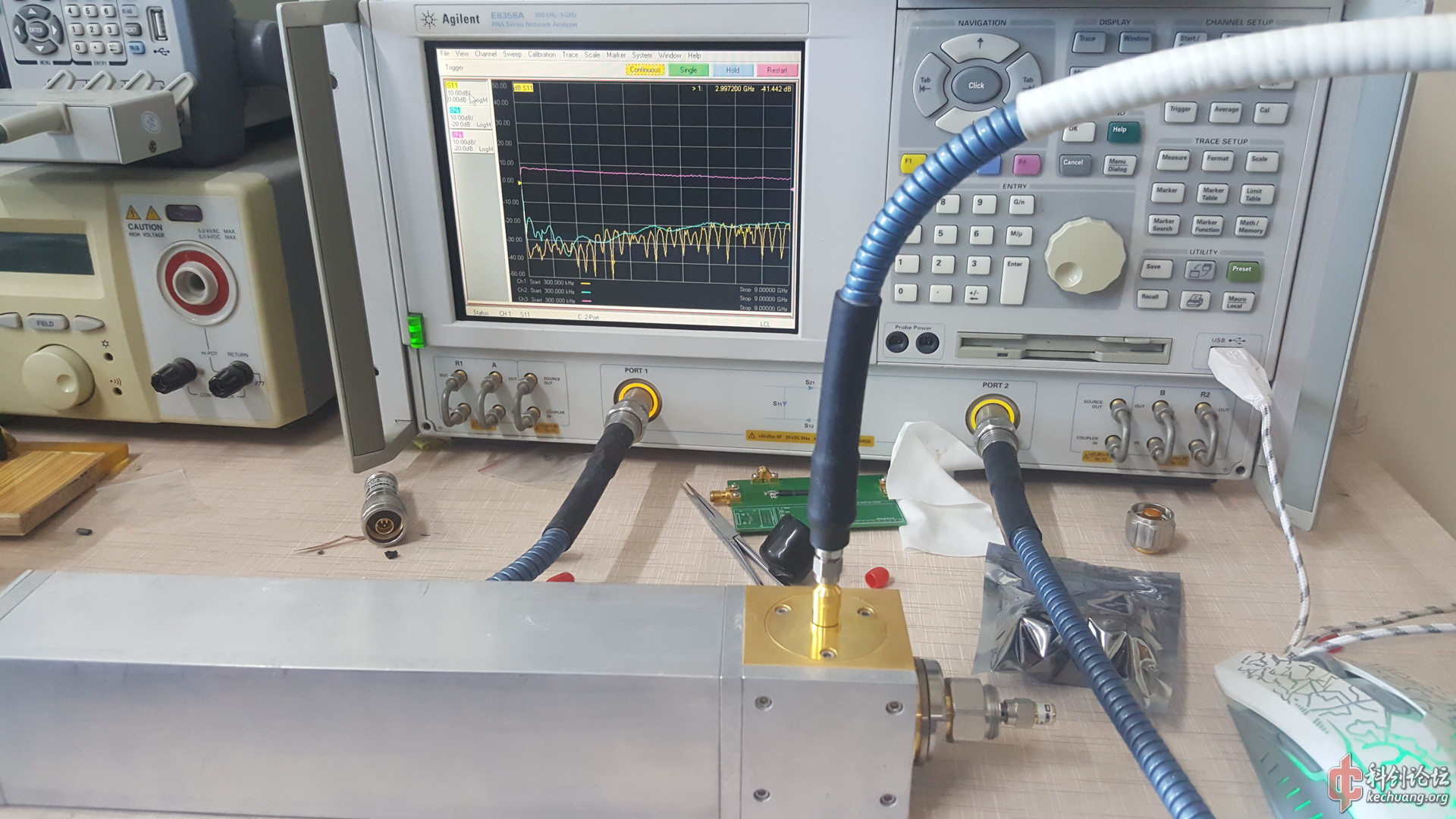
测试端口的样子
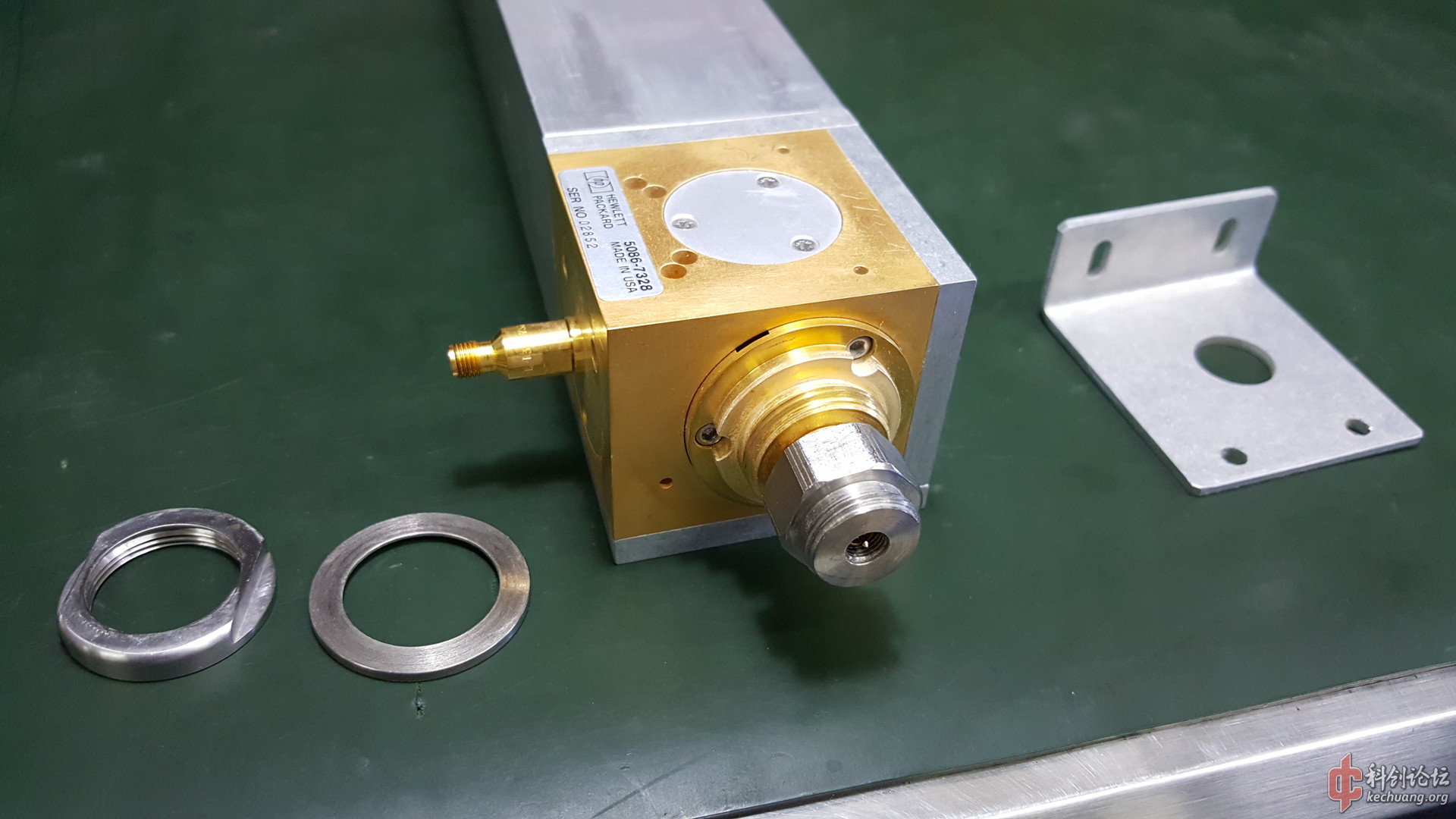
撸起袖子加油拆,这是顶盖打开后的样子,一个弹簧压住一个小盖板
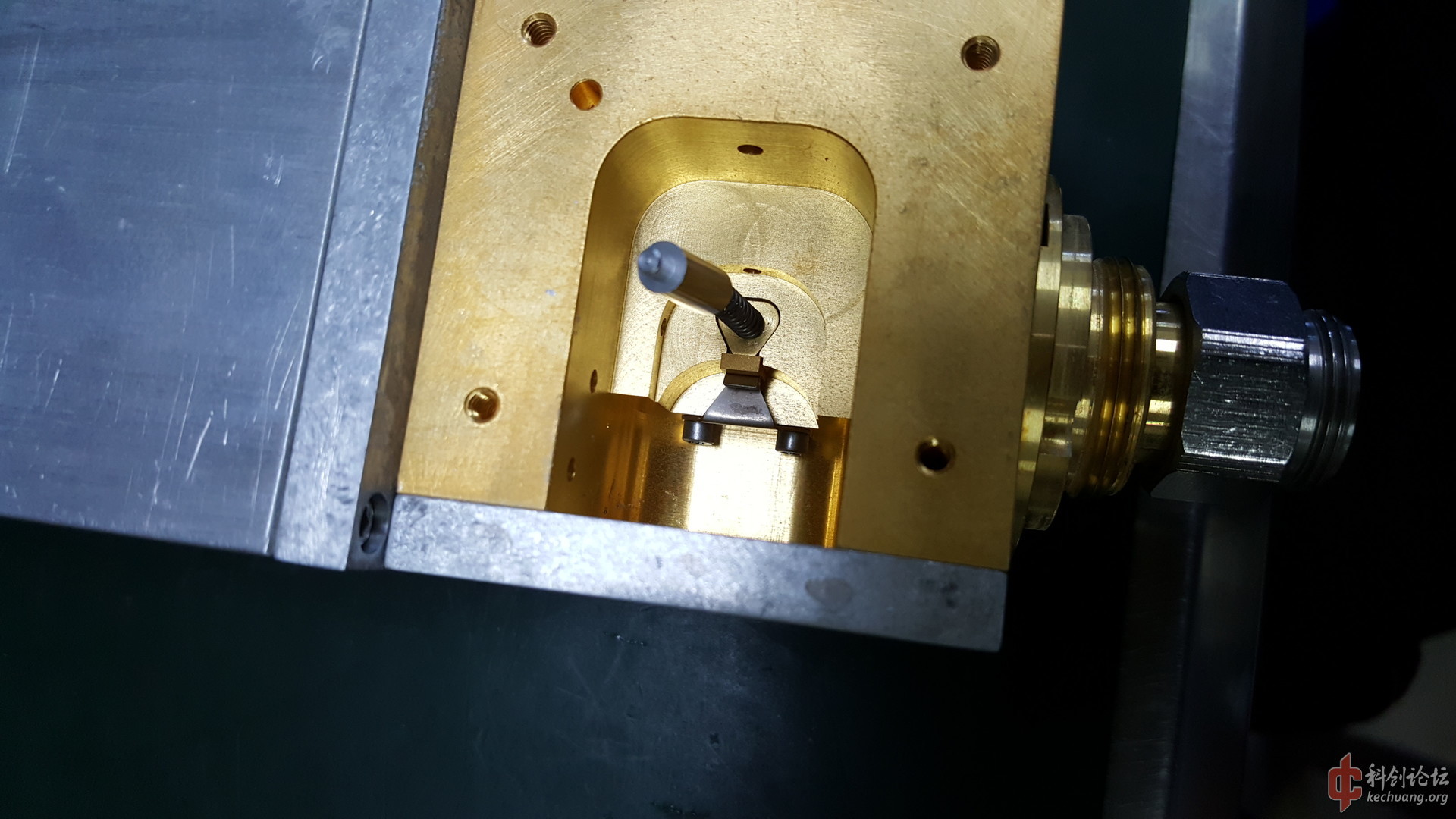
把侧盖也打开,可以看到那个小盖板
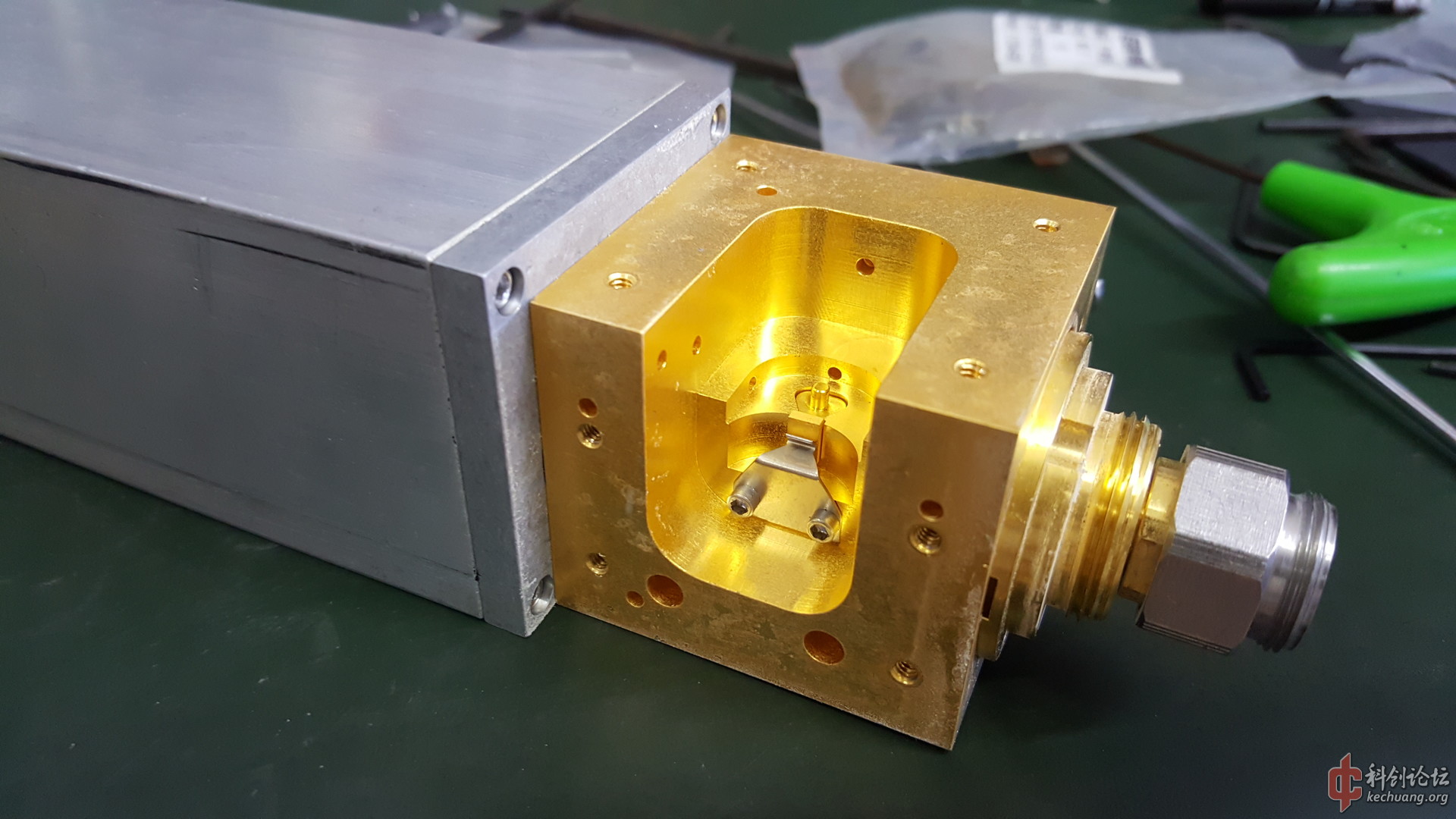
取下的零件和小盖板
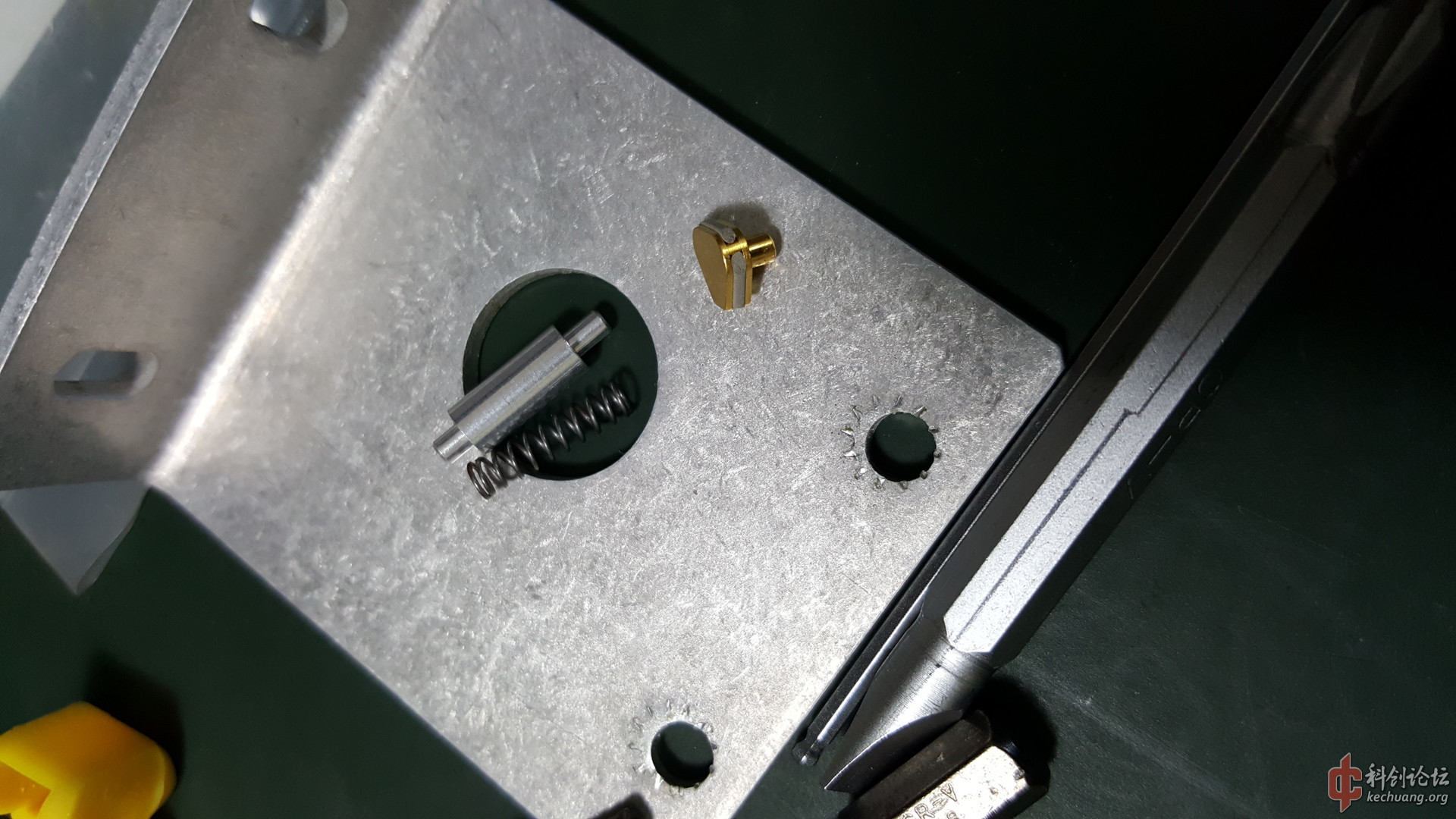
这是电桥的两个臂,按照惠普高端产品的习惯,应该是蓝宝石片上做的镀层
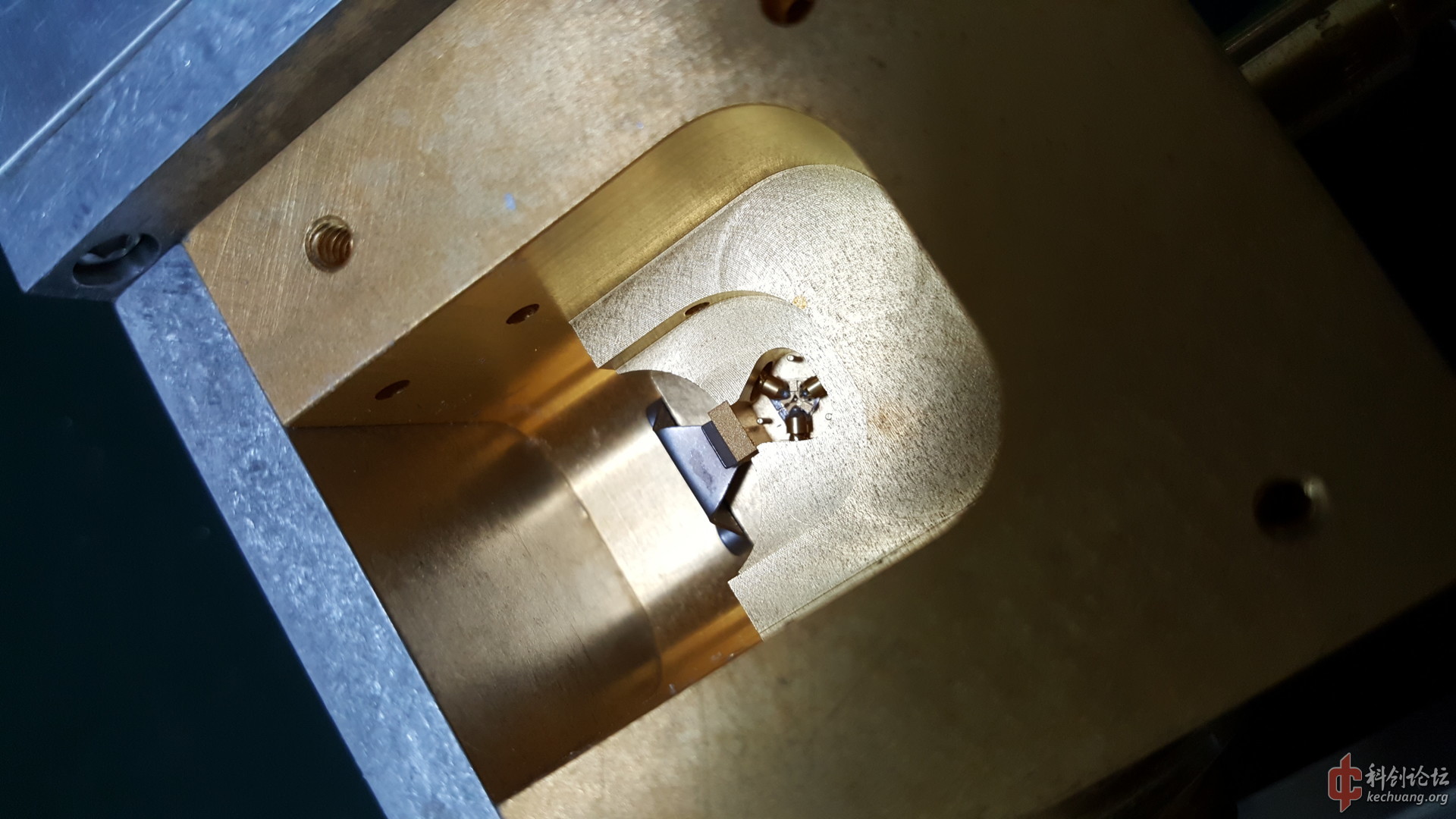
用显微镜看一看,上面有4个电阻,两个电容。注意右下角狭缝中心的细线,那是同轴电缆的芯线。同轴电缆的外壳一端焊接在了桥的一个臂上。
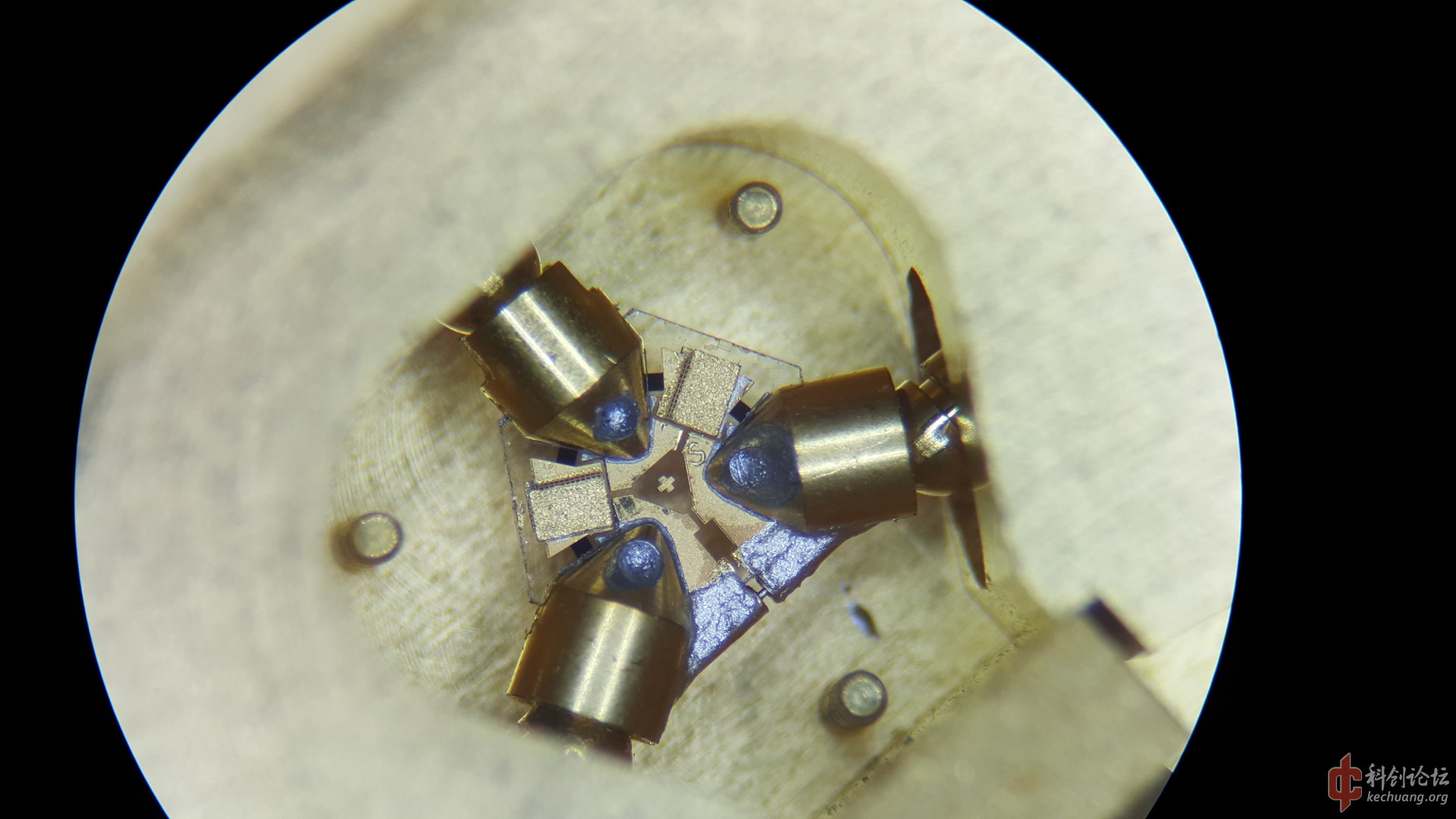
背面就是一个金属块塞上。当然塞多进去应该是根据机械配合和阻抗要求调过的。
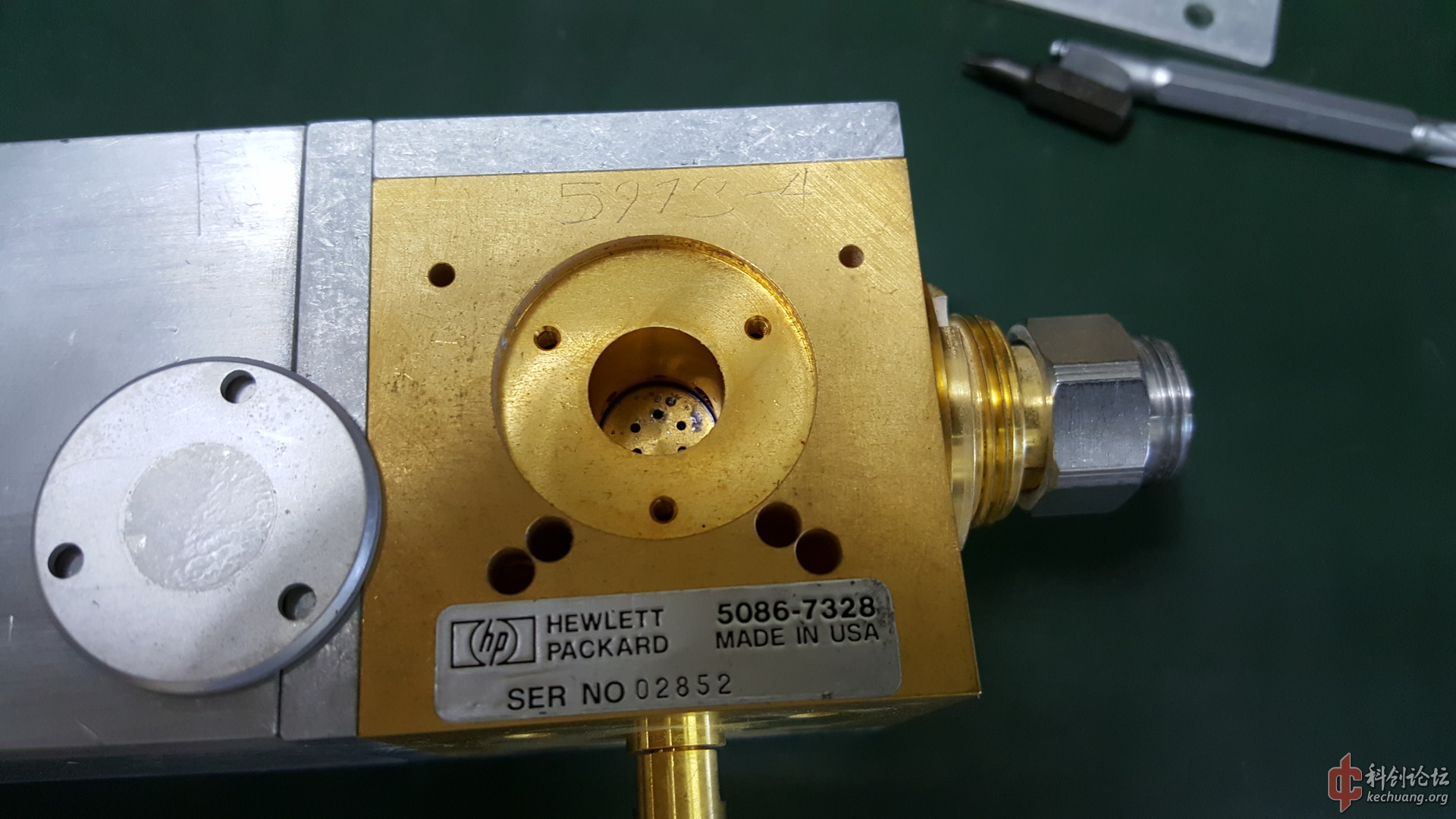
3.5连接器下面是一个可以拆卸的可阀过渡段(其实是空的,和空气线差不多的性能),这个零件支撑了刚才看到的蓝宝石电桥。

不出所料,我把两个同轴支撑都取下来了。

一头是一段可以伸缩的球头

肚子里面有一个0.6mm左右的小弹簧

蓝宝石已经只剩上面提到过的同轴线连着了,摇摇欲坠。这次拆解是希望不破坏现场、最后能够复装的,但是看到这里,就已经不详预感了。

为了拆下同轴线,看到巴伦部分,必须从大肚子上开刀

这个桥的机械设计很坑,英制的不到3mm的内六角螺丝在距离表面接近30厘米处,淘宝上搜遍,最长的螺丝刀只有25厘米长。。无奈,自己磨一把。

还是拆下来了,就是最里面的螺丝孔

华丽的内心闪亮登场

然后,然后,同轴线断了。这些接头都涂了紧固胶,是上机床搞开的,因为3.5锁紧螺套被粘死无法旋动,不得不整体旋转拧断了内部的同轴线。其实后来想了下,断是必然的。要想不断,应该先拆小肚子,用烙铁搞开细同轴的一端;也可以先融化蓝宝石上的焊线。

这个线需要用显微镜看

外壳直径0.3mm

绝缘体外径0.18mm。芯线直径……不好意思,我没有完整的剥开过。

继续看巴伦,细同轴线此时套在了一个稍微粗点(大约1mm直径)的铜管内

拆开以后——弹性的支架上放满了磁体材料,调节螺丝可以调整这些磁体的松紧

磁体灰飞烟灭啦,看到了巴伦的核心部分

巴伦处是两层套管,内层是0.8mm左右同轴线,然后装在1.2mm左右的镀金铜(不一定,看着像)管内。在最右侧,内层同轴线才转成刚才看到的0.3mm同轴线。由于最近实验室装修无法开伦琴机,转换器内结构未知。

这是插进同轴线转换段的一节渐变金属管,内部结构不清楚

这个看着像3.5mm接头的东西,其实芯针中心还要穿过一根同轴电缆(那个小孔)

这个看着像玻璃窗的东西,其实是一个电阻

它真的是一个电阻

不出所料,电桥肚子里面有一张惠普经典的,已经老化的海绵。

文字内容仅供参考。
THE END
大家可以探讨下。
[修改于 6年4个月前 - 2018/01/02 00:32:23]
本着刨根问底精神,咱构思了若干关键词进行检索,但相关信息极少,甚至没有。这个电桥据说是5815A矢网的一部分,但是8515A的电桥似乎比这玩意儿小,频率范围也不太一样,很可能是同样的其它零件,单独换了这个桥的某种产品,型号不清楚。根据这些信息,未能找到相关资料。
按照惠普的一贯作风,每个零件都应该有对应的专利。于是到专利局去,根据@RodTech 的提示猜测的关键词,以及大概年代等信息,终于找到了这东西的原始出处。
美国专利US.4720677,1988年申请。下面是详细资料,讲得极为清楚,连用了什么公司的材料都毫无保留的予以披露(电阻材料或磁性材料搭配上似乎与顶楼实物略有不同),可以当教科书读。为了方便阅读,图片的位置我做了对应调整。
BACKGROUND OF THE INVENTION
This invention relates to R.F. network analyzers, and particularly to very broadband R.F. directional bridges for performing vector measurements and time domain reflectometry.
Characterizing circuits in the frequency domain is a fundamental activity in both the design and testing of electronic circuits. Only by knowing the gain/phase-vs-frequency characteristics and the input-output impedances of each circuit can one assemble a complete device capable of meeting performance objectives. In recent years, significant progress has been made in the development of network analyzers to characterize component and circuit performance. By providing plots of gain or loss, phase shift and reflection coefficients versus frequency, these instruments have given electronic engineers in depth practical insight into circuit and component behavior. In addition, with better computational devices and wider bandwidth measuring instruments, time domain reflectometry is more readily available which further enhances insight into circuit behavior and leads to more precise designs. In turn, these designs have led to tighter system performance requirements, for example, closer packing of communications channels and this in turn has led to a demand for even better measuring instruments. At the heart of such measuring instruments is the directional bridge for separating reflected and transmitted signals from incident signals, e.g., in order to characterize the S-parameters of a device under test (D.U.T.). Such a prior art bridge is shown in FIG. 1. Here the device is typically symmetric relative to the R.F. input, with the resistance of resistors R1 and R2 being equal to each other, and equal in value to that of load resistor R0, i.e., R1=R2=R0. The device is typically implemented with a balun B between reference port (REF) and test port (T), and with a termination resistor R3=R0 for extracting the signal. As a practical matter, however, the circuit of FIG. 1 is highly idealized. If the balun and termination are replaced by equivalent realistic impedances, the difficulties in constructing such a device become readily apparent. A corresponding equivalent circuit is shown in FIG. 2. Here, R1=R2=R0 as before. However, for satisfactory measurements the following requirements must be satisfied: (1) the parasitic shunt impedances ZB and ZC must be very large, i.e., ZB>>R0 and ZC>>Z D.U.T. where Z D.U.T. is the impedance of the device under test; or (2) ZB and ZC must be extremely well balanced, i.e., ZB=ZC exactly; or (3) ZB and ZC must satisfy some relation which is a compromise between (1) and (2) above. For measuring instruments which are restricted to a few octaves or less in bandwidth, these restrictions can usually be met without extreme measures. However, above 1 to 2 GHz, it becomes very difficult to produce a broadband impedance greater than about 1 K ohm, since the impedance decreases rapidly with increasing frequency. Hence, higher frequencies impose very stringent requirements for balancing of the two shunt impedances. As a result, for very wide bandwidth devices, e.g., over the entire range from 45 MHz to 26.5 GHz, it does not appear physically possible with the present state of the art to provide such high impedances or such precise balancing. Nevertheless, wide bandwidth directional bridges are highly desirable for automated test equipment using broadband sweepers to characterize circuit parameters and are particularly important for performing Fourier transforms for accurate time domain reflectometry, a technique which has proven extremely useful in solving intricate design problems. To date, the practical difficulties of extracting the desired differential signal over such a wide bandwidth without introducing unbalanced parasitic impedances has eluded the industry.
![4.png]()
SUMMARY OF THE INVENTION
In accordance with the preferred embodiments of the invention provided is a design for a terminated R.F./microwave Wheatstone bridge and a precision termination which can be used therewith.
The precision termination has an essentially constant impedance over a very wide range of frequencies, the return loss being 40 dB or less from 1 GHz to 26.5 GHz and less than 34 dB from 45 MHz to 16 Hz. The termination has three distinct portions. A first portion having a continuous load element having inner taper of a relatively loss free dielectric and an outer taper of a lossy material, the combination providing a constant impedance in the higher frequencies. (This first continuous taper portion which is dielectrically loaded is useful by itself for a high frequency termination.) This first portion, however, includes two additional tapered sections which are stepwise tapered to broaden the bandwidth of this first portion. A second portion of the precision termination is made up of a lumped load attached to the tapered portion. A third portion includes a ferrite bead distributed load attached to the lumped load opposite the tapered load.
The Wheatstone bridge is made up of a microcircuit which has a test port return loss of less than or equal to 20 dB over the entire range for frequencies from 45 MHz to 26.5 GHz. With a nominal impedance between the various ports (i.e., test port, reflection port, and reference port) of 50 ohms, this low return loss is accomplished by keeping the electrical path length in the various arms between ports at or below 0.1 the wavelength at the highest frequency.
DETAILED DESCRIPTION OF THE INVENTION
In accordance with preferred embodiments of the invention, shown in FIG. 3 is a design for an R.F. terminated Wheatstone bridge which does not require either high shunt impedance or delicate balancing. Here all the elements and relationships are the same as those in FIG. 2, except that the shunt impedance ZC is substantially eliminated and ZB is made to be R0, where R0 is a constant impedance (typically 50 ohms) over the frequencies of interest, thus eliminating the separate resistor for that function and achieving a balanced bridge. With this structure, it can be shown by simple circuit analysis that the floating voltage VT, generated across the terminating impedance ZA, is proportional to the reflection coefficient of the D.U.T.
While the built-in detector of a scalar bridge can easily convert the floating R.F. voltage VT to a single-ended D.C. output, the vector bridge of FIG. 3 is faced with a much more severe challenge. It must extract the floating R.F. signal and feed it to a single ended vector detection system, without upsetting the delicate symmetry and impedance level of the bridge. For this reason, it should be readily apparent that R0 must be a precision element with a flat response over the entire frequency range of interest, which in the preferred embodiment is generally from 45 MHz to 26.5 GHz. In order to provide such a constant impedance over this large bandwidth, R0 is typically a composite system as depicted in FIG. 4. As illustrated, R0 has three distinct elements. The first, R01, is a high frequency distributed load for preventing signals at the reference port from seeing any shunt impedance other than R0. Unlike an isolated lumped resistor which provides virtually no isolation, such a distributed load can be made to provide almost any degree of isolation commensurate with acceptable dimensions. Such isolation requires, however, that there be sufficient loss per unit length to avoid introducing shunt impedance at the frequencies of interest. Losses of 20-25 dB along the length of the load (40-50 dB isolation) are generally sufficient to avoid bridge imbalance.
The second stage of the reference impedance, R02, is a lumped load placed at the end of R01 to provide a termination at lower frequencies where losses in the distributed load, R01, are insufficient to achieve isolation. To avoid parasitic shunt impedances at these lower frequencies, the third stage, R03, a ferrite core (balun), is added to keep the shunt reactance high. The magnitude of the impedances of R02 and R03 are chosen so that their combined parallel impedance is equal to R0 since R01 is transparent at low frequencies.
Another important feature of this structure is its triaxial nature, i.e., having a center conductor C1 inside a coaxial conducting sheath C2, which is itself inside a second coaxial conductor C3. Because the input and detector ports of a vector bridge are functionally interchangeable, either port may be driven while the other extracts the reflected signal. Hence, by reversing the orientation from that shown in FIG. 4 and driving from the balun end R03, the test port T can be D.C. biased by means of center conductor C1 (e.g., to provide power to transistors and I.C.'s in the D.U.T.). Such a reflectometer design is illustrated schematically in FIG. 5A. Here the balun and R' together represent the reference impedance R0. The system is fed through an R.F. power splitter 11 to provide a reference signal and to supply power to the bridge. b1 corresponds to the signal at port I together and b2 corresponds to the signal after transmission through the D.U.T.
![2.png]()
The vector ratio b1/a1 is proportional to the input reflection coefficient while b2/a1 is proportional to the transmission coefficient of the D.U.T.. Also, included is a D.C. block 12 for isolating the R.F. power input from the bias voltage provided by bias input 13 on the center conductor of the reference impedance R0. Shown in FIG. 5B is a typical reflection/transmission test setup which is particularly adapted for use by an automated R.F. network analyzer.
In accordance with the preferred embodiments of the invention, a practical implementation of the bridge and the accompanying precision broadband load assembly is depicted in a somewhat exploded view in FIG. 6. The system is made up of a bridge assembly housing 1, which contains a bridge microcircuit 6 (shown in enlarged view in FIG. 6A) for providing electrical connections between the reflection port, the test port and the reference port. Also included in housing 1 is an adjustable spring loaded top ground plane 2. Also shown is a coax assembly 3 (also illustrated in an enlarged view in FIG. 6B) for connecting the high frequency portion R01 of the reference load to the reference port of the microwave bridge. This is accomplished by providing a tapered transition from center coax 10 of R01 to center coax 7 of the reference port which feeds microcircuit 6, the transition being accomplished by means of an inner taper 9 and an outer taper 8 as shown in FIG. 7A. At the other end of the distributed portion of the R01 reference load is the lumped load R02 which is made up of a 61.5 ohm resistor 22 and an inner conductor 24 and outer conductor 23. Attached to lumped load R02 is the balun section R03 made up of a series of ferrite beads, such as bead 21, located on the coax. The impedance of R03 is generally chosen to be about 285 ohms in order to provide a combined shunt impedance with R02 of 50 ohms.
![3.png]()
Balun R03 is typically formed into a single loop for mechanical stress relief purposes and a pad of polyurethane foam 26 is formed around it for protection from impact. Coax assembly 16 then provides connection for R.F. input and D.C. bias, and a grommet 5 is used to stabilize the positions of loads R02 and R03 in a load shroud assembly 17.
Shown in FIG. 7A is an expanded view of distributed load R01 and lumped load R02. For purposes of discussion, all elements not already described previously will be numbered in the 700's to associate that element with FIG. 7. Element 701 is a bottom ground plane, typically aluminum, having a groove therein to accommodate the distributed load material of the triaxial structure. as can be seen from FIGS. 7A and 7B tapered loads 711 and 712 typically provide a constant impedance distributed load for frequencies above about 8 GHz, while the balance of the loads 713 through 740 are for achieving a flat response in the intermediate frequency ranges. As illustrated in FIG. 7B, tapered loads 711 and 712 are physically mated to achieve a snug fit. Tapered load 711 is typically constructed of a relatively lowless material such as cross-linked polystyrene having a relative dielectric constant of about 2.54 (e.g., STYCAST 0005, which is manufactured by Emerson & Cuming) so that the distributed load is dielectrically loaded on the front end rather than relying on air as the dielectric. This dielectric loading is very important in achieving the desired matching characteristics with the lumped load. At the front end of tapered load 711 the preferred diameter is about 0.1497 inches, while at the distal end the preferred diameter is about 0.0797 inches. The preferred length for tapered load 711 is generally about 1.959 inches with taper beginning about 0.230 inches from the front. Tapered load 712 is typically constructed of a machineable lossy material such as MF112 which is also manufactured by Emerson & Cuming. Table I provides a list of the electromagnetic characteristics of MF112 as a function of frequency.
![5.png]()
表1
![11.png]()
![12.png]()
The balance of the distributed load, i.e., loads 13 through 40, carries through this tapered load concept, except that the loads are stepwise tapered. Generally step tapered terminations have a relatively narrow bandwidth and critical dimensionality. However, by using lossy loads in multiple steps (i.e., multiple loads) the bandwidth can be increased while at the same time reducing the overall length of the distributed load section. In addition, the use of lossy loads provides a forgiving structure, since subsequent losses in successive loads tend to obscure reflections at interfaces between loads. As indicated in FIG. 7A in the first stepwise taper, inner loads 713, 715, 717, and load spacer 720 are typically constructed of STYCAST 0005 material, while outer loads 714, 716, 718, and 719, and inner loads 721, 723, 725, 727, 729, 731, 733, 735, and 737 are typically constructed of MF112 material. The second stepwise taper begins at load 722 and continues through load 740, with loads 722, 724, 726, 728, 730, 732, 734, 736, 738, 739, and 740 being constructed of MF124, a material produced by Emerson & Cuming which has a substantially higher loss than MF112. Table I also lists the electromagnetic characteristics of MF124 as a function of frequency. MF112 and MF124 were chosen because they are a mixture of lossy elements in a base material which is the same as STYCAST 0005. Hence, at low frequencies where the lossy elements have a minimal loss contribution, the outer taper resembles the inner taper, so that the distributed portion and the lumped load termination together are essentially matched to the reference impedance. Table II is a list of the inside and outside diameters of each of the loads. The linear dimension of each load is 0.25 inches, except for load 719 which is 0.230 inches long and load 719 which together with load spacer 720 totals 0.25 inches. As indicated in drawings 7A, 7B, and 7C, the loads are strung in close contact on a center conductor 705. The diameter of center conductor 705 is nominally 0.0474 inches.
![12.png]()
Holding loads 710 through 740 in place is an adjustable top ground plane 741, typically constructed of gold-plated berylliumcopper and nominally having a width W of 0.237 inches, a depth D of 0.197 inches, and a length L of 5.735 inches (see FIGS. 7A and 7E). Holes in the top of ground plane 741 permit press blocks 748 to extend through the top surface to contact conductive shoes 747 which in turn contact the lower flanges of the top ground plane, in order to push them into firm contact with the load elements (see FIG. 7D for a cross-section showing the deformation of the top ground plane on the outer surface of the load). The force for press blocks 748 is furnished by set screws 755 and 756 mounted in a top housing 753. This ability to tune the individual load elements via the top ground plane is particularly important in achieving a precision load since step-tapered loads can be particularly sensitive to small changes in magnetic and dielectric properties. It should also be noted that throughout the system, RFI round strip conductive elastomeric gaskets 708 are provided to insure good electrical contact.
![6.png]()
![7.png]()
Shown in FIG. 7C is the tail end of the reference load illustrating the single loop of the inner coax threaded through a sequence of nine (9) ferrite shielding beads 757. Such beads are used because they have a high magnetic permeability and are very lossy, so that when the inner coax is eventually shorted to ground, there will be enough series loss to isolate the short and provide a precision reference termination. A typical material for beads 757 is Ferroxcube material 3B (available from Hewlett-Packard Company as stock number 9170-0016), having an initial magnetic permeability of 900 at 20 degrees Celsius. Beads 757 typically have an inner diameter of 0.051 inches, and outer diameter of 0.138 inches, and are 0.159 inches long, so as to achieve an impedance of 300 ohms in this balun section. FIGS. 7F1 and 7F2 are plots of the electrical characteristics of beads 757.
![8.png]()
Shown in FIGS. 7G1 and 7G2 is an expanded view of lumped resistor 709 (the equivalent of R02 of FIG. 4). It is generally constructed by connecting inner and outer rings of gold-coated sapphire with eight identical, equally spaced, resistors 758 to obtain a combined resistance of 61.5 ohms.
![14.png]()
The outer diameter of the outer ring of the sapphire substrate is typically 0.345 inches and the inner diameter is typically 0.270 inches. The outer diameter of the inner ring is typically 0.135 inches and the inner diameter of the inner ring is typica11y 0.075 inches. Resistors 758 are generally constructed of tantalum. Other typical dimensions shown in FIGS. 7G1 and 7G2 are:
![15.png]()
Shown in FIG. 8A is a magnified view of microcircuit 6 which was described briefly in reference to FIG. 6. The microcircuit is formed on a hexagonal sapphire substrate 801 (shown in detail in FIG. 8B) which has a nominal thickness of 10 mils. Geometrically, the circuit has reflection symmetry in a plane passing through the center of the reflection port and the center of the circuit 840. However, the hexagon is not regular. Opposite sides are parallel, sides 802, 803, and 804 are equal in length, and sides 805 and 807 are equal in length. However, side 802 is not the same length as 805 or 806. Table III gives a list of preferred dimensions for the microcircuit. Typically, the gold pattern and tantalum resistors 809, 810, 811, and 812 shown in FIGS. 8A and 8B are put down on both faces of the substrate with resistors on one face being disposed immediately opposite resistors on the other face. The resistance of each resistor 809, 810, 811, and 812 and their counterparts on the opposite face of the substrate is nominally 50.0 ohms, so that the combined resistance in each leg, i.e., between the reflection port and the reference port is 50 ohms and between the reflection port and the test port is 50 ohms. This results from the fact that each leg has a series resistance of 100 ohms on each face, and the two faces provide parallel connections to the ports. The use of two (2) parallel paths per arm helps to pull down the inductance of the system. Four (4) barium titanate single layer dielectric capacitors 814 (two (2) on each face of the substrate with each one opposite an identical one on the opposite face of the substrate) are epoxied in place in series with the resistors and gold wire mesh is used to make electrical contact between gold pads 819 and capacitors 814. Each capacitor is nominally 350 picofarads, and capacitors on opposite faces of the substrate are oriented in opposite direction for symmetry reasons.
![10.png]()
![17.png]()
Arrowheads 821, 822, and 823 for providing electrical and mechanical connections to each port are typically constructed of beryllium copper turned on a numerically controlled screw machine to a diameter of 0.060 inches. The overall length of the arrowheads is 0.080 inches and includes a cone portion having a length of 0.037 inches to avoid introducing unwanted capacitance into the system. Each cone portion is slotted to a width of about 11 mils to accommodate the 10 mil substrate and is soldered to the substrate via solder holes such as 824. Each arrowhead is gold plated to insure good electrical contact. Also shown in FIG. 8A is inner coax 825 which extends through the reference port arrowhead. Its center conductor 826 bridges a gap 827 of about 0.003 inches and makes contact with a dummy coax 829 typically a conducting rod which electrically connects center conductor 826 directly to the test port. Gap 827 then acts as an R.F. generator midway between the test and reference ports. The diameter of conductor 829, typically 0.013 inches, is the same as the diameter of inner coax 825 in order to maintain electrical and physical symmetry as to both the test port and reference port.
Despite the efforts at maintaining electrical and physical symmetry between ports, it is important to note that such symmetry alone is not sufficient to achieve an adequate port match. This can be most easily seen by noting that looking into the microcircuit from the generator with the test port terminated in 50 ohms, the transmission lines from the generator to the test port and reflection port should be 25 ohms for best termination (since the reflection port looks like a virtual ground because of the symmetry of the device). However, on terminating the reflection port in 50 ohms instead of the test port and looking into the microcircuit from the test port, the desired impedance should look like 100 ohms in each branch, i.e., from the test port to ground through the reflection port,and from the test port to ground through the reference port. To accommodate this poor port match, the microcircuit itself is made very small in order that the parasitic impedances introduced by the microcircuit are small relative to the 50 ohm operating impedance. By deciding on a design criterion for test port return loss, the corresponding maximum desired electrical path length between ports can be calculated using the following relationship:
![16.png]()
where L is the electrical path length. By choosing the small interconnecting transmission lines between ports to be approximately 50 ohms and with a design of 20 dB test port return loss, the maximum desired electrical path length in any one of the three arms is found to be 0.10 of the wavelength at the highest frequency. For the geometry described above, this corresponds to 0.045 inches at 26.5 GHz.
Another unique feature of microcircuit 6 is that it is mechanically supported totally by its electrical connections. As illustrated in FIG. 9, which is a cross-section of housing 1, outer coax 901, supports the microcircuit at the reference port. The end most tip of outer coax 901 is typically hemispherical in shape with a hole therethrough to accommodate inner coax 825, and contacts the drilled end 921 of arrowhead 821. The test port of the microcircuit is supported by a spring loaded ball joint 903 which contacts the drilled end 922 of arrowhead 822. The reflection port is supported by a spring loaded piece of slabline 905 which rests in a slot 923 cut in the end of arrowhead 823. This manner of three element mechanical support permits very stable mounting which also permits electrical adjustment within the housing by placing tuning screws (not shown) through bottom ground plane 910 of housing 1 directly under the joint between each arrowhead and its electrical/mechanical connection.
![1.png]()
剧终。
按照惠普的一贯作风,每个零件都应该有对应的专利。于是到专利局去,根据@RodTech 的提示猜测的关键词,以及大概年代等信息,终于找到了这东西的原始出处。
美国专利US.4720677,1988年申请。下面是详细资料,讲得极为清楚,连用了什么公司的材料都毫无保留的予以披露(电阻材料或磁性材料搭配上似乎与顶楼实物略有不同),可以当教科书读。为了方便阅读,图片的位置我做了对应调整。
BACKGROUND OF THE INVENTION
This invention relates to R.F. network analyzers, and particularly to very broadband R.F. directional bridges for performing vector measurements and time domain reflectometry.
Characterizing circuits in the frequency domain is a fundamental activity in both the design and testing of electronic circuits. Only by knowing the gain/phase-vs-frequency characteristics and the input-output impedances of each circuit can one assemble a complete device capable of meeting performance objectives. In recent years, significant progress has been made in the development of network analyzers to characterize component and circuit performance. By providing plots of gain or loss, phase shift and reflection coefficients versus frequency, these instruments have given electronic engineers in depth practical insight into circuit and component behavior. In addition, with better computational devices and wider bandwidth measuring instruments, time domain reflectometry is more readily available which further enhances insight into circuit behavior and leads to more precise designs. In turn, these designs have led to tighter system performance requirements, for example, closer packing of communications channels and this in turn has led to a demand for even better measuring instruments. At the heart of such measuring instruments is the directional bridge for separating reflected and transmitted signals from incident signals, e.g., in order to characterize the S-parameters of a device under test (D.U.T.). Such a prior art bridge is shown in FIG. 1. Here the device is typically symmetric relative to the R.F. input, with the resistance of resistors R1 and R2 being equal to each other, and equal in value to that of load resistor R0, i.e., R1=R2=R0. The device is typically implemented with a balun B between reference port (REF) and test port (T), and with a termination resistor R3=R0 for extracting the signal. As a practical matter, however, the circuit of FIG. 1 is highly idealized. If the balun and termination are replaced by equivalent realistic impedances, the difficulties in constructing such a device become readily apparent. A corresponding equivalent circuit is shown in FIG. 2. Here, R1=R2=R0 as before. However, for satisfactory measurements the following requirements must be satisfied: (1) the parasitic shunt impedances ZB and ZC must be very large, i.e., ZB>>R0 and ZC>>Z D.U.T. where Z D.U.T. is the impedance of the device under test; or (2) ZB and ZC must be extremely well balanced, i.e., ZB=ZC exactly; or (3) ZB and ZC must satisfy some relation which is a compromise between (1) and (2) above. For measuring instruments which are restricted to a few octaves or less in bandwidth, these restrictions can usually be met without extreme measures. However, above 1 to 2 GHz, it becomes very difficult to produce a broadband impedance greater than about 1 K ohm, since the impedance decreases rapidly with increasing frequency. Hence, higher frequencies impose very stringent requirements for balancing of the two shunt impedances. As a result, for very wide bandwidth devices, e.g., over the entire range from 45 MHz to 26.5 GHz, it does not appear physically possible with the present state of the art to provide such high impedances or such precise balancing. Nevertheless, wide bandwidth directional bridges are highly desirable for automated test equipment using broadband sweepers to characterize circuit parameters and are particularly important for performing Fourier transforms for accurate time domain reflectometry, a technique which has proven extremely useful in solving intricate design problems. To date, the practical difficulties of extracting the desired differential signal over such a wide bandwidth without introducing unbalanced parasitic impedances has eluded the industry.
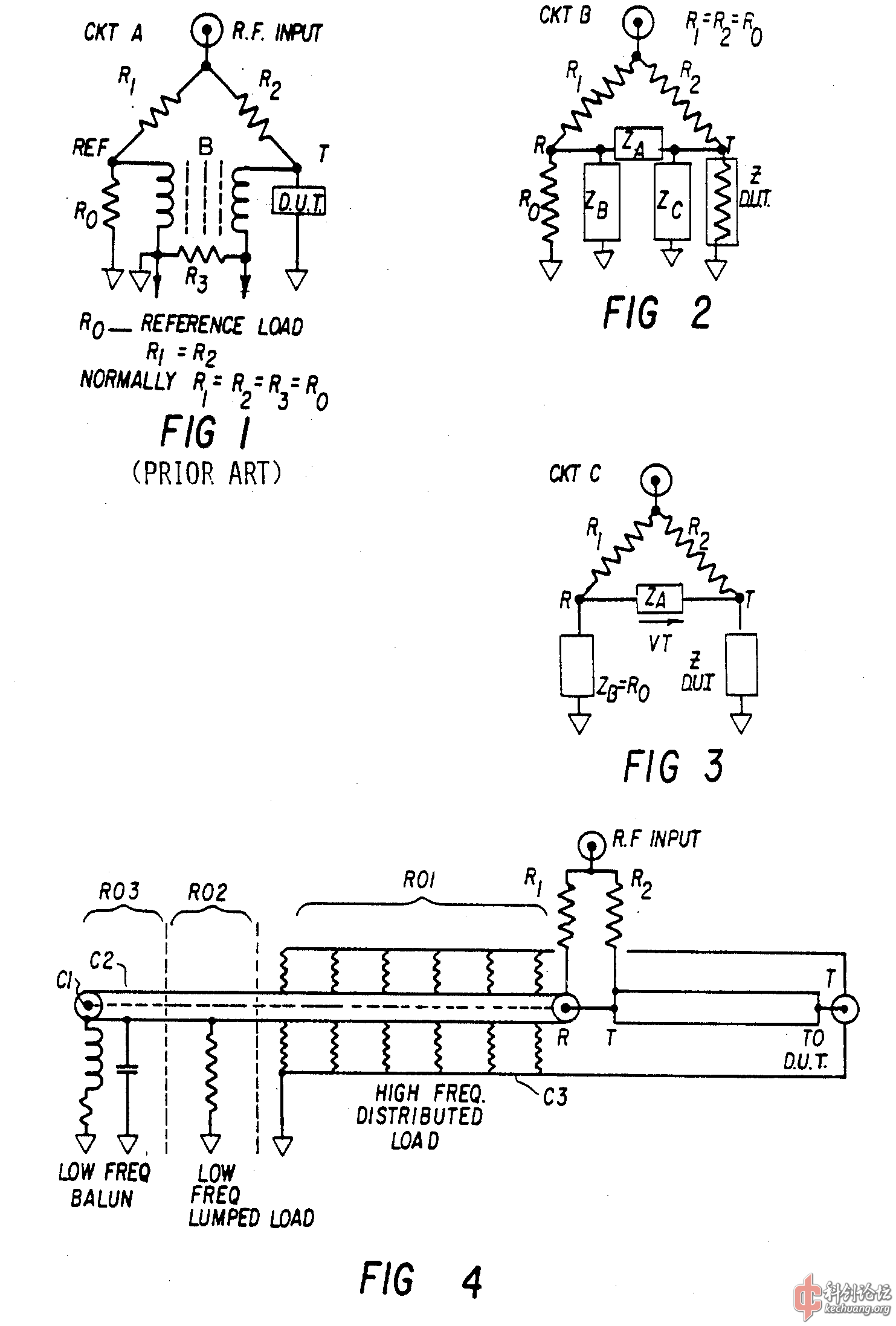
SUMMARY OF THE INVENTION
In accordance with the preferred embodiments of the invention provided is a design for a terminated R.F./microwave Wheatstone bridge and a precision termination which can be used therewith.
The precision termination has an essentially constant impedance over a very wide range of frequencies, the return loss being 40 dB or less from 1 GHz to 26.5 GHz and less than 34 dB from 45 MHz to 16 Hz. The termination has three distinct portions. A first portion having a continuous load element having inner taper of a relatively loss free dielectric and an outer taper of a lossy material, the combination providing a constant impedance in the higher frequencies. (This first continuous taper portion which is dielectrically loaded is useful by itself for a high frequency termination.) This first portion, however, includes two additional tapered sections which are stepwise tapered to broaden the bandwidth of this first portion. A second portion of the precision termination is made up of a lumped load attached to the tapered portion. A third portion includes a ferrite bead distributed load attached to the lumped load opposite the tapered load.
The Wheatstone bridge is made up of a microcircuit which has a test port return loss of less than or equal to 20 dB over the entire range for frequencies from 45 MHz to 26.5 GHz. With a nominal impedance between the various ports (i.e., test port, reflection port, and reference port) of 50 ohms, this low return loss is accomplished by keeping the electrical path length in the various arms between ports at or below 0.1 the wavelength at the highest frequency.
DETAILED DESCRIPTION OF THE INVENTION
In accordance with preferred embodiments of the invention, shown in FIG. 3 is a design for an R.F. terminated Wheatstone bridge which does not require either high shunt impedance or delicate balancing. Here all the elements and relationships are the same as those in FIG. 2, except that the shunt impedance ZC is substantially eliminated and ZB is made to be R0, where R0 is a constant impedance (typically 50 ohms) over the frequencies of interest, thus eliminating the separate resistor for that function and achieving a balanced bridge. With this structure, it can be shown by simple circuit analysis that the floating voltage VT, generated across the terminating impedance ZA, is proportional to the reflection coefficient of the D.U.T.
While the built-in detector of a scalar bridge can easily convert the floating R.F. voltage VT to a single-ended D.C. output, the vector bridge of FIG. 3 is faced with a much more severe challenge. It must extract the floating R.F. signal and feed it to a single ended vector detection system, without upsetting the delicate symmetry and impedance level of the bridge. For this reason, it should be readily apparent that R0 must be a precision element with a flat response over the entire frequency range of interest, which in the preferred embodiment is generally from 45 MHz to 26.5 GHz. In order to provide such a constant impedance over this large bandwidth, R0 is typically a composite system as depicted in FIG. 4. As illustrated, R0 has three distinct elements. The first, R01, is a high frequency distributed load for preventing signals at the reference port from seeing any shunt impedance other than R0. Unlike an isolated lumped resistor which provides virtually no isolation, such a distributed load can be made to provide almost any degree of isolation commensurate with acceptable dimensions. Such isolation requires, however, that there be sufficient loss per unit length to avoid introducing shunt impedance at the frequencies of interest. Losses of 20-25 dB along the length of the load (40-50 dB isolation) are generally sufficient to avoid bridge imbalance.
The second stage of the reference impedance, R02, is a lumped load placed at the end of R01 to provide a termination at lower frequencies where losses in the distributed load, R01, are insufficient to achieve isolation. To avoid parasitic shunt impedances at these lower frequencies, the third stage, R03, a ferrite core (balun), is added to keep the shunt reactance high. The magnitude of the impedances of R02 and R03 are chosen so that their combined parallel impedance is equal to R0 since R01 is transparent at low frequencies.
Another important feature of this structure is its triaxial nature, i.e., having a center conductor C1 inside a coaxial conducting sheath C2, which is itself inside a second coaxial conductor C3. Because the input and detector ports of a vector bridge are functionally interchangeable, either port may be driven while the other extracts the reflected signal. Hence, by reversing the orientation from that shown in FIG. 4 and driving from the balun end R03, the test port T can be D.C. biased by means of center conductor C1 (e.g., to provide power to transistors and I.C.'s in the D.U.T.). Such a reflectometer design is illustrated schematically in FIG. 5A. Here the balun and R' together represent the reference impedance R0. The system is fed through an R.F. power splitter 11 to provide a reference signal and to supply power to the bridge. b1 corresponds to the signal at port I together and b2 corresponds to the signal after transmission through the D.U.T.

The vector ratio b1/a1 is proportional to the input reflection coefficient while b2/a1 is proportional to the transmission coefficient of the D.U.T.. Also, included is a D.C. block 12 for isolating the R.F. power input from the bias voltage provided by bias input 13 on the center conductor of the reference impedance R0. Shown in FIG. 5B is a typical reflection/transmission test setup which is particularly adapted for use by an automated R.F. network analyzer.
In accordance with the preferred embodiments of the invention, a practical implementation of the bridge and the accompanying precision broadband load assembly is depicted in a somewhat exploded view in FIG. 6. The system is made up of a bridge assembly housing 1, which contains a bridge microcircuit 6 (shown in enlarged view in FIG. 6A) for providing electrical connections between the reflection port, the test port and the reference port. Also included in housing 1 is an adjustable spring loaded top ground plane 2. Also shown is a coax assembly 3 (also illustrated in an enlarged view in FIG. 6B) for connecting the high frequency portion R01 of the reference load to the reference port of the microwave bridge. This is accomplished by providing a tapered transition from center coax 10 of R01 to center coax 7 of the reference port which feeds microcircuit 6, the transition being accomplished by means of an inner taper 9 and an outer taper 8 as shown in FIG. 7A. At the other end of the distributed portion of the R01 reference load is the lumped load R02 which is made up of a 61.5 ohm resistor 22 and an inner conductor 24 and outer conductor 23. Attached to lumped load R02 is the balun section R03 made up of a series of ferrite beads, such as bead 21, located on the coax. The impedance of R03 is generally chosen to be about 285 ohms in order to provide a combined shunt impedance with R02 of 50 ohms.

Balun R03 is typically formed into a single loop for mechanical stress relief purposes and a pad of polyurethane foam 26 is formed around it for protection from impact. Coax assembly 16 then provides connection for R.F. input and D.C. bias, and a grommet 5 is used to stabilize the positions of loads R02 and R03 in a load shroud assembly 17.
Shown in FIG. 7A is an expanded view of distributed load R01 and lumped load R02. For purposes of discussion, all elements not already described previously will be numbered in the 700's to associate that element with FIG. 7. Element 701 is a bottom ground plane, typically aluminum, having a groove therein to accommodate the distributed load material of the triaxial structure. as can be seen from FIGS. 7A and 7B tapered loads 711 and 712 typically provide a constant impedance distributed load for frequencies above about 8 GHz, while the balance of the loads 713 through 740 are for achieving a flat response in the intermediate frequency ranges. As illustrated in FIG. 7B, tapered loads 711 and 712 are physically mated to achieve a snug fit. Tapered load 711 is typically constructed of a relatively lowless material such as cross-linked polystyrene having a relative dielectric constant of about 2.54 (e.g., STYCAST 0005, which is manufactured by Emerson & Cuming) so that the distributed load is dielectrically loaded on the front end rather than relying on air as the dielectric. This dielectric loading is very important in achieving the desired matching characteristics with the lumped load. At the front end of tapered load 711 the preferred diameter is about 0.1497 inches, while at the distal end the preferred diameter is about 0.0797 inches. The preferred length for tapered load 711 is generally about 1.959 inches with taper beginning about 0.230 inches from the front. Tapered load 712 is typically constructed of a machineable lossy material such as MF112 which is also manufactured by Emerson & Cuming. Table I provides a list of the electromagnetic characteristics of MF112 as a function of frequency.

表1


The balance of the distributed load, i.e., loads 13 through 40, carries through this tapered load concept, except that the loads are stepwise tapered. Generally step tapered terminations have a relatively narrow bandwidth and critical dimensionality. However, by using lossy loads in multiple steps (i.e., multiple loads) the bandwidth can be increased while at the same time reducing the overall length of the distributed load section. In addition, the use of lossy loads provides a forgiving structure, since subsequent losses in successive loads tend to obscure reflections at interfaces between loads. As indicated in FIG. 7A in the first stepwise taper, inner loads 713, 715, 717, and load spacer 720 are typically constructed of STYCAST 0005 material, while outer loads 714, 716, 718, and 719, and inner loads 721, 723, 725, 727, 729, 731, 733, 735, and 737 are typically constructed of MF112 material. The second stepwise taper begins at load 722 and continues through load 740, with loads 722, 724, 726, 728, 730, 732, 734, 736, 738, 739, and 740 being constructed of MF124, a material produced by Emerson & Cuming which has a substantially higher loss than MF112. Table I also lists the electromagnetic characteristics of MF124 as a function of frequency. MF112 and MF124 were chosen because they are a mixture of lossy elements in a base material which is the same as STYCAST 0005. Hence, at low frequencies where the lossy elements have a minimal loss contribution, the outer taper resembles the inner taper, so that the distributed portion and the lumped load termination together are essentially matched to the reference impedance. Table II is a list of the inside and outside diameters of each of the loads. The linear dimension of each load is 0.25 inches, except for load 719 which is 0.230 inches long and load 719 which together with load spacer 720 totals 0.25 inches. As indicated in drawings 7A, 7B, and 7C, the loads are strung in close contact on a center conductor 705. The diameter of center conductor 705 is nominally 0.0474 inches.

Holding loads 710 through 740 in place is an adjustable top ground plane 741, typically constructed of gold-plated berylliumcopper and nominally having a width W of 0.237 inches, a depth D of 0.197 inches, and a length L of 5.735 inches (see FIGS. 7A and 7E). Holes in the top of ground plane 741 permit press blocks 748 to extend through the top surface to contact conductive shoes 747 which in turn contact the lower flanges of the top ground plane, in order to push them into firm contact with the load elements (see FIG. 7D for a cross-section showing the deformation of the top ground plane on the outer surface of the load). The force for press blocks 748 is furnished by set screws 755 and 756 mounted in a top housing 753. This ability to tune the individual load elements via the top ground plane is particularly important in achieving a precision load since step-tapered loads can be particularly sensitive to small changes in magnetic and dielectric properties. It should also be noted that throughout the system, RFI round strip conductive elastomeric gaskets 708 are provided to insure good electrical contact.


Shown in FIG. 7C is the tail end of the reference load illustrating the single loop of the inner coax threaded through a sequence of nine (9) ferrite shielding beads 757. Such beads are used because they have a high magnetic permeability and are very lossy, so that when the inner coax is eventually shorted to ground, there will be enough series loss to isolate the short and provide a precision reference termination. A typical material for beads 757 is Ferroxcube material 3B (available from Hewlett-Packard Company as stock number 9170-0016), having an initial magnetic permeability of 900 at 20 degrees Celsius. Beads 757 typically have an inner diameter of 0.051 inches, and outer diameter of 0.138 inches, and are 0.159 inches long, so as to achieve an impedance of 300 ohms in this balun section. FIGS. 7F1 and 7F2 are plots of the electrical characteristics of beads 757.

Shown in FIGS. 7G1 and 7G2 is an expanded view of lumped resistor 709 (the equivalent of R02 of FIG. 4). It is generally constructed by connecting inner and outer rings of gold-coated sapphire with eight identical, equally spaced, resistors 758 to obtain a combined resistance of 61.5 ohms.

The outer diameter of the outer ring of the sapphire substrate is typically 0.345 inches and the inner diameter is typically 0.270 inches. The outer diameter of the inner ring is typically 0.135 inches and the inner diameter of the inner ring is typica11y 0.075 inches. Resistors 758 are generally constructed of tantalum. Other typical dimensions shown in FIGS. 7G1 and 7G2 are:

Shown in FIG. 8A is a magnified view of microcircuit 6 which was described briefly in reference to FIG. 6. The microcircuit is formed on a hexagonal sapphire substrate 801 (shown in detail in FIG. 8B) which has a nominal thickness of 10 mils. Geometrically, the circuit has reflection symmetry in a plane passing through the center of the reflection port and the center of the circuit 840. However, the hexagon is not regular. Opposite sides are parallel, sides 802, 803, and 804 are equal in length, and sides 805 and 807 are equal in length. However, side 802 is not the same length as 805 or 806. Table III gives a list of preferred dimensions for the microcircuit. Typically, the gold pattern and tantalum resistors 809, 810, 811, and 812 shown in FIGS. 8A and 8B are put down on both faces of the substrate with resistors on one face being disposed immediately opposite resistors on the other face. The resistance of each resistor 809, 810, 811, and 812 and their counterparts on the opposite face of the substrate is nominally 50.0 ohms, so that the combined resistance in each leg, i.e., between the reflection port and the reference port is 50 ohms and between the reflection port and the test port is 50 ohms. This results from the fact that each leg has a series resistance of 100 ohms on each face, and the two faces provide parallel connections to the ports. The use of two (2) parallel paths per arm helps to pull down the inductance of the system. Four (4) barium titanate single layer dielectric capacitors 814 (two (2) on each face of the substrate with each one opposite an identical one on the opposite face of the substrate) are epoxied in place in series with the resistors and gold wire mesh is used to make electrical contact between gold pads 819 and capacitors 814. Each capacitor is nominally 350 picofarads, and capacitors on opposite faces of the substrate are oriented in opposite direction for symmetry reasons.


Arrowheads 821, 822, and 823 for providing electrical and mechanical connections to each port are typically constructed of beryllium copper turned on a numerically controlled screw machine to a diameter of 0.060 inches. The overall length of the arrowheads is 0.080 inches and includes a cone portion having a length of 0.037 inches to avoid introducing unwanted capacitance into the system. Each cone portion is slotted to a width of about 11 mils to accommodate the 10 mil substrate and is soldered to the substrate via solder holes such as 824. Each arrowhead is gold plated to insure good electrical contact. Also shown in FIG. 8A is inner coax 825 which extends through the reference port arrowhead. Its center conductor 826 bridges a gap 827 of about 0.003 inches and makes contact with a dummy coax 829 typically a conducting rod which electrically connects center conductor 826 directly to the test port. Gap 827 then acts as an R.F. generator midway between the test and reference ports. The diameter of conductor 829, typically 0.013 inches, is the same as the diameter of inner coax 825 in order to maintain electrical and physical symmetry as to both the test port and reference port.
Despite the efforts at maintaining electrical and physical symmetry between ports, it is important to note that such symmetry alone is not sufficient to achieve an adequate port match. This can be most easily seen by noting that looking into the microcircuit from the generator with the test port terminated in 50 ohms, the transmission lines from the generator to the test port and reflection port should be 25 ohms for best termination (since the reflection port looks like a virtual ground because of the symmetry of the device). However, on terminating the reflection port in 50 ohms instead of the test port and looking into the microcircuit from the test port, the desired impedance should look like 100 ohms in each branch, i.e., from the test port to ground through the reflection port,and from the test port to ground through the reference port. To accommodate this poor port match, the microcircuit itself is made very small in order that the parasitic impedances introduced by the microcircuit are small relative to the 50 ohm operating impedance. By deciding on a design criterion for test port return loss, the corresponding maximum desired electrical path length between ports can be calculated using the following relationship:

where L is the electrical path length. By choosing the small interconnecting transmission lines between ports to be approximately 50 ohms and with a design of 20 dB test port return loss, the maximum desired electrical path length in any one of the three arms is found to be 0.10 of the wavelength at the highest frequency. For the geometry described above, this corresponds to 0.045 inches at 26.5 GHz.
Another unique feature of microcircuit 6 is that it is mechanically supported totally by its electrical connections. As illustrated in FIG. 9, which is a cross-section of housing 1, outer coax 901, supports the microcircuit at the reference port. The end most tip of outer coax 901 is typically hemispherical in shape with a hole therethrough to accommodate inner coax 825, and contacts the drilled end 921 of arrowhead 821. The test port of the microcircuit is supported by a spring loaded ball joint 903 which contacts the drilled end 922 of arrowhead 822. The reflection port is supported by a spring loaded piece of slabline 905 which rests in a slot 923 cut in the end of arrowhead 823. This manner of three element mechanical support permits very stable mounting which also permits electrical adjustment within the housing by placing tuning screws (not shown) through bottom ground plane 910 of housing 1 directly under the joint between each arrowhead and its electrical/mechanical connection.

剧终。
引用
1
加载评论中,请稍候...
200字以内,仅用于支线交流,主线讨论请采用回复功能。
震撼。总有人能出人意料地想出新奇的结构。传输线套传输线,化解杂散分布电容,这主意真的震到我了。
引用
加载评论中,请稍候...
200字以内,仅用于支线交流,主线讨论请采用回复功能。
引用 量子隧道:我倒是觉得这个主意不算太破天荒,毕竟是物理原理的直接呈现,算不上拐弯抹角。震惊的是,这玩意儿竟然能做出来,还能批量生产。
震撼。总有人能出人意料地想出新奇的结构。传输线套传输线,化解杂散分布电容,这主意真的震到我了。
引用
加载评论中,请稍候...
200字以内,仅用于支线交流,主线讨论请采用回复功能。
引用 虎哥:我最近也在为测量臂上的分布电容所困扰。我能想到的也就是尽量远离周围的导体。所以刚一看到这个想法,是真的眼前一亮。
我倒是觉得这个主意不算太破天荒,毕竟是物理原理的直接呈现,算不上拐弯抹角。震惊的是,这玩意儿竟然能做出来,还能批量生产。
可生产性是个大问题。两层嵌套的传输线,外传输线不能太粗,否则就会产生高阶模(非TEM模),破坏了单模传输条件。而这势必导致内传输线很细。这就要求尺寸误差要非常小,避免内传输线阻抗失配。而且内传输线非常细,要和各种标准接头对接,那种渐变过渡,更是难做。居然被hp实现了。
引用
加载评论中,请稍候...
200字以内,仅用于支线交流,主线讨论请采用回复功能。
前边的图有个地方标错了。“高频巴伦”和“高频平衡电阻”其实都是些损耗介质。看专利,是些磁损耗材料。“高频巴伦”是高损耗介质。“高频平衡电阻”是低损耗介质。当然,每个元件还做成了阶梯形或渐变锥,实现从右到左损耗逐渐增大。这样外传输线构成了一个高频损耗传输线,这个传输线构成了电桥的一个电阻。即参考电阻R0。
真是服了惠普这帮工程师。
真是服了惠普这帮工程师。
引用
加载评论中,请稍候...
200字以内,仅用于支线交流,主线讨论请采用回复功能。
引用 量子隧道:是的,这个是当时没资料的情况下根据经验猜测的。上面的那些多边形磁珠是用来微调平衡的,磁场对介质中的波产生“灵敏的”作用。但是需要注意,那些小的介质并不一定都是吸收用的,不一定一点磁阻作用都没有,否则那个61欧电阻和介质电阻是直接并联关系,要想调平衡在低频段的负载分配就变得非常考究,很难平滑拼接。
前边的图有个地方标错了。
需要说明的是,这个桥由于成本太高,已经不生产了,甚至这种结构也很少见到。现在大家又回到了“减少电容,升高干扰阻抗”的老路。这些老的结构,只有历史研究价值,并不能指导现在的设计。
楼上如果做的是等臂电桥,其实对分布电容的敏感度不是那么高,结构上做对称,让两边抵消,就能用到比较高的频率(继续升高由于桥的S11恶化,也很困难)。不知你打算做到多少G?
引用
加载评论中,请稍候...
200字以内,仅用于支线交流,主线讨论请采用回复功能。
是的。那些“高频巴伦”,掺杂了磁性材料,主要靠磁性吸波,顺便也可以起到左右隔离的作用。可以一定程度抵消失配带来的影响,减少低频失配导致的R0偏离理想值太远。
我在做6GHz的等臂电桥。在PCB板上做。把附近的地都挖空。如果能把PCB介质(会提高杂散电容)也挖掉就更好了。不过这么做会导致电阻没地方焊,只能搭棚了。
我在做6GHz的等臂电桥。在PCB板上做。把附近的地都挖空。如果能把PCB介质(会提高杂散电容)也挖掉就更好了。不过这么做会导致电阻没地方焊,只能搭棚了。
引用
加载评论中,请稍候...
200字以内,仅用于支线交流,主线讨论请采用回复功能。
引用 量子隧道:这个取决于你的指标要求,普通的指标下,6G的等臂桥部分很简单,倒是巴伦不好做。
我在做6GHz的等臂电桥。在PCB板上做。把附近的地都挖空。如果能把PCB介质(会提高杂散电容)也挖掉就更好了。不过这么做会导致电阻没地方焊,只能搭棚了。
引用
加载评论中,请稍候...
200字以内,仅用于支线交流,主线讨论请采用回复功能。
换一个角度看,这个电桥和下面链接里的电桥其实是一回事(除了等臂与不等臂的区别)。
链接里的电桥,如果按照本文看,同轴线的外皮和系统的地,势必要构成一个9.3ohm的有损传输线。然而链接里的电桥,直接简单粗暴地把9.3ohm有损传输线换成了9.3ohm的电阻。也能跑到20GHz的频率。
XXXXXXXXXXXXXXXXXXX/XXXXXXXXXXXXXXXXXXXXXXXXml
链接里的电桥,如果按照本文看,同轴线的外皮和系统的地,势必要构成一个9.3ohm的有损传输线。然而链接里的电桥,直接简单粗暴地把9.3ohm有损传输线换成了9.3ohm的电阻。也能跑到20GHz的频率。
XXXXXXXXXXXXXXXXXXX/XXXXXXXXXXXXXXXXXXXXXXXXml
引用
加载评论中,请稍候...
200字以内,仅用于支线交流,主线讨论请采用回复功能。
引用 虎哥:我是处于自己做着玩的状态,对低频延伸要求不高,能到20MHz就可以了。所以我也可以做比较简单的balun。
这个取决于你的指标要求,普通的指标下,6G的等臂桥部分很简单,倒是巴伦不好做。
引用
加载评论中,请稍候...
200字以内,仅用于支线交流,主线讨论请采用回复功能。
我记得上次和你探讨这个问题是半年前了,不知道进展怎么样,期待您的详细报导,争取超过老外。
目前15GHz的901采用非等臂电桥,主要是其巴伦容易实现一些,另外它能够得到更大的输出。就非等臂电桥而言,说起来简单,要做好也是很难的。您的资料上,到10G大约只有15dB定向性,再高就会迅速恶化,毫无悬念。
与老外帖子的指标相比,目前我们是这个水平。
![1.jpg]()
目前15GHz的901采用非等臂电桥,主要是其巴伦容易实现一些,另外它能够得到更大的输出。就非等臂电桥而言,说起来简单,要做好也是很难的。您的资料上,到10G大约只有15dB定向性,再高就会迅速恶化,毫无悬念。
与老外帖子的指标相比,目前我们是这个水平。

引用
加载评论中,请稍候...
200字以内,仅用于支线交流,主线讨论请采用回复功能。
引用 虎哥:道阻且长。我鼓捣了2个版本了,才刚把一个bug揪出来。这个bug不是关于电桥和balun的,是关于混频器的。所以我前期对电桥还不怎么上心,没有刻意优化。
我记得上次和你探讨这个问题是半年前了,不知道进展怎么样,期待您的详细报导,争取超过老外。
我记得上个版本,我对比过电桥给出的tx和rx能量差(电桥的DUT端用50欧校准件端接),6GHz内全频段大于16dB。基本大于20dB。在5GHz处有个地方鼓起来了,导致接近16db。总体上还好。我不知道5GHz附近的rx鼓包是我的电桥的原因还是端接头的原因,没刻意分辨过。
我没有用VNA单独测过电桥(原因是我自己没有VNA)。
这个版本我还未抽出时间焊接和调试。所以结果不知。
科创这个电桥看起来性能很好,我看基本上9GHz以内定向性大于25db了。
引用
加载评论中,请稍候...
200字以内,仅用于支线交流,主线讨论请采用回复功能。
我记得上次和你探讨这个问题是半年前了,不知道进展怎么样,期待您的详细报导,争取超过老外。目前15GH...
为了搞清楚对电桥性能起决定性作用的影响要素,这几天试了建了3个电桥的模型,做了电磁结构仿真。为了达到>20dB的定向性,电桥的电阻的位置需要以0.1mm的颗粒度挪动。在仿真环境里获得25dB的定向性是可以的,但是电阻的位置精度需要保证在0.1mm以下。我怀疑即使能通过仿真找到最优解,我也难以通过自己的手工焊接重现这个最优解。
稍候有空的话我会开一贴讨论一下这个探索过程。
科创的电桥是如何保证批量加工后还可以保证批量后的一致性的?感觉这是个很难的问题。不是现今的通用电子装配工艺可以解决的难题。
引用
1
加载评论中,请稍候...
200字以内,仅用于支线交流,主线讨论请采用回复功能。